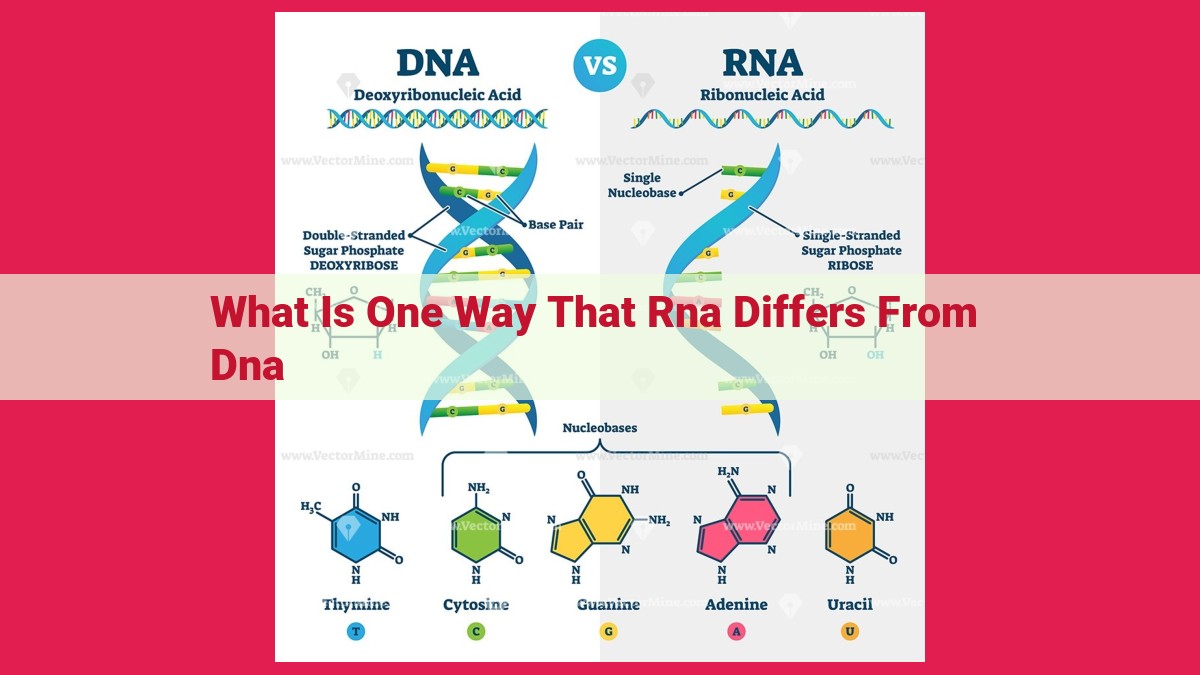Understanding The Key Differences Between Rna And Dna: Structure, Function, And Roles In Protein Synthesis

RNA, unlike DNA, is single-stranded, making it more flexible. This flexibility is essential for its diverse roles in messenger (mRNA), transfer (tRNA), and ribosomal (rRNA) functions during protein synthesis. Additionally, RNA contains a different type of sugar molecule (ribose) and uracil instead of thymine, influencing its base pairing properties. These structural and chemical differences enable RNA to play a more dynamic role in cellular processes compared to DNA, which primarily serves as a stable repository of genetic information.
Understanding the Differences Between RNA and DNA: Unraveling the Genetic Code
In the intricate symphony of life, the molecules of RNA and DNA play pivotal roles as the cornerstones of genetic information. They carry the blueprints for our existence, dictating the intricate processes that govern our health, development, and even our evolutionary journey. While both are nucleic acids, essential for the storage and transmission of genetic information, they possess subtle yet critical differences that underpin their distinct functions within the cell.
To fully grasp the complexities of life, it’s imperative to delve into the differences between RNA and DNA. Understanding these distinctions provides a window into the meticulous molecular machinery that orchestrates the symphony of life. So, let’s embark on a journey to unravel the genetic code, exploring the fundamental contrasts between RNA and DNA.
Key Differences Between RNA and DNA: A Molecular Tale of Two Genomes
In the intricate tapestry of life, two молекулярных гигантов, RNA and DNA, play pivotal roles in orchestrating genetic processes. While often intertwined in their functions, RNA and DNA possess distinct characteristics that set them apart in the cellular landscape.
Single-stranded vs. Double-stranded: The Architecture of Stability
RNA exists primarily as a single-stranded molecule, while DNA boasts a double-stranded helix. This architectural difference stems from the number of sugar-phosphate backbones present. DNA, with its double-stranded nature, forms a more stable structure, akin to a sturdy ladder with two rails. In contrast, RNA’s single-stranded configuration resembles a flexible, swaying ribbon.
Ribose Sugar vs. Deoxyribose Sugar: A Subtle Chemical Distinction
Delving deeper, the sugar molecules at the heart of these nucleic acids hold another key: they differ in the presence or absence of an oxygen atom. RNA’s ribose sugar bears an -OH group at its 2′ carbon, while DNA’s deoxyribose sugar lacks this hydroxyl moiety. This subtle difference has profound implications for their chemical reactivity and stability.
Uracil vs. Thymine: A Variation in the Genetic Code
Nitrogenous bases, the building blocks of the genetic code, also reveal a critical distinction between RNA and DNA. Uracil is a cornerstone of RNA’s alphabet, while thymine takes its place in DNA’s genetic blueprint. This variation in base composition affects how RNA and DNA interact with their molecular partners and interpret genetic information.
Functional Implications of the Differences Between RNA and DNA
The unique structural and chemical distinctions between RNA and DNA have profound implications for their respective roles in cellular processes.
RNA: The Versatile Player
RNA serves as a versatile and multifaceted molecule in the cell, involved in a wide range of functions. Its single-stranded nature allows it to fold into intricate structures, enabling it to engage in complex interactions with proteins and other molecules.
One of the central roles of RNA is in protein synthesis, where it serves as a messenger carrying genetic instructions from DNA to the ribosomes, the protein factories of the cell. Furthermore, RNA also plays a crucial role in gene regulation, controlling the expression of genes and influencing cellular behavior.
DNA: The Genetic Guardian
In contrast to RNA, DNA is primarily a genetic blueprint, responsible for storing and transmitting genetic information. Its double-stranded structure, with its complementary base pairing, ensures accuracy and stability of the genetic code. This stability allows DNA to withstand cellular processes such as replication and repair without compromising the integrity of the genetic material.
The double helix structure of DNA also provides protection against environmental factors that could potentially damage the genetic code. Unlike RNA, DNA is not as susceptible to degradation by enzymes, contributing to its long-term stability and the preservation of genetic information across cell generations.
The structural and chemical differences between RNA and DNA shape their distinct roles in cellular processes. RNA, with its versatility and single-stranded nature, plays an active role in protein synthesis, gene regulation, and a myriad of other cellular functions. DNA, on the other hand, serves as a stable and secure genetic blueprint, ensuring the accurate and reliable transmission of genetic information. These differences highlight the exquisite design and complexity of cellular processes, where each molecule plays a crucial and interconnected role in the symphony of life.